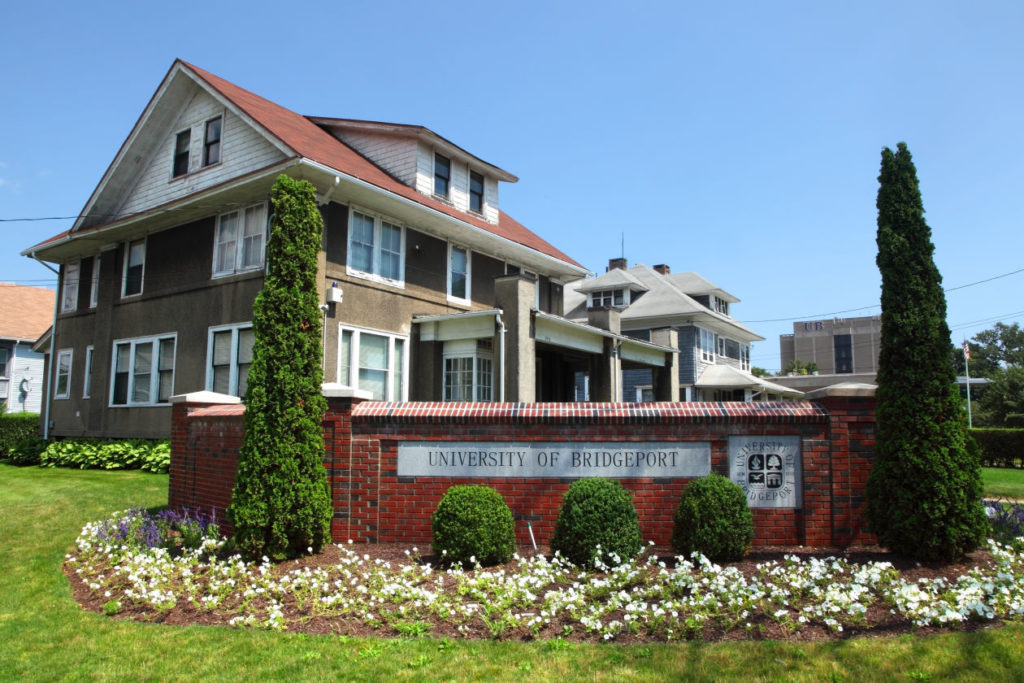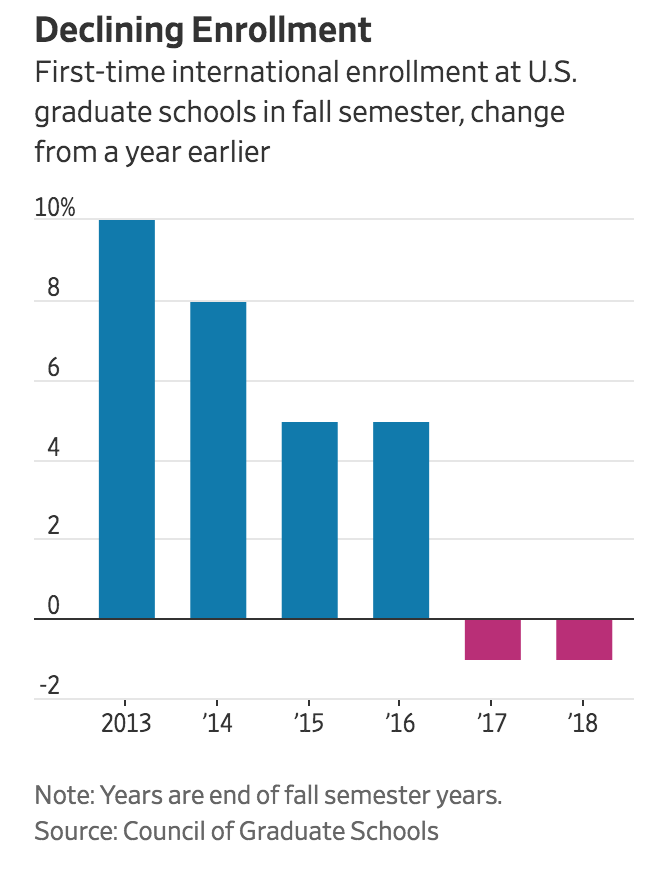Fewer International Students Heading To The U.S. (#GotBitcoin?)
American colleges and universities face growing challenge amid rising competition from other countries, concerns about safety and immigration policies. Fewer International Students Heading To The U.S. (#GotBitcoin?)
U.S. enrollment of international students declined for the second year in a row, sending waves of unease across American colleges and universities, which see students from abroad as a buffer against the falling number of U.S. high-school students graduating each year.
The number of new international students enrolling at American institutions fell by 6.6% during the 2017-18 academic year, on top of a 3.3% decline the year before, according to a report by the Institute of International Education released Tuesday.
Meanwhile, the total number of international students in the U.S. plus those working here on a student visa rose by just 1.5% this year. That was down from average annual growth of 6.1% over the past decade, a period during which enrollment of international students doubled.
Foreign students are big business: They pumped $42 billion into U.S. college and university coffers in the 2017-18 school year alone.
Students from abroad are still flocking to the coasts, but are less interested in the South and Midwest.
The shift is due to a combination of politics, fear, geography and branding, said Alejandra Sosa Pieroni, an international recruitment expert with Ruffalo Noel Levitz, a company that consults with colleges to improve enrollment.
“Students are not feeling welcome in some states, so they are looking beyond those states and heading to places where they will feel welcome,” she said.
The slowdown comes as U.S. schools struggle with demographic and revenue challenges due to the falling number of Americans graduating from high school. As a result, U.S. colleges and universities have become increasingly dependent on revenue generated from international students. Public schools often charge international students more than what domestic students pay.
The U.S. is also losing students to English-speaking countries such as Canada, Australia and the U.K, which have all seen growth in the past year.
“We’re hearing that they have choices; we’re hearing that there’s competition from other countries,” said Allan E. Goodman, president of the Institute of International Education.
Graduate schools were hardest hit among all segments of the higher-education market: Enrollment fell by 2.1%.
“It has become increasingly difficult to get a student visa in my country with the policy nowadays,” said Mohamed Gumaa, a master’s engineering student from Sudan who is studying at Texas Tech University.
China remained the largest single source of international students, accounting for about a third of all students who come to the U.S. for postsecondary degrees. The number of students coming from Canada and Mexico, meanwhile, fell by 4.3% and 8.1%, respectively.
The Northeast enjoyed the highest rate of growth in the number of overall international student visas at 3.4%, followed by the West at 1.9% and the South with 0.9%. International student visas in the Midwest fell 0.4%.
“There seems to be a higher level of comfort” in big cities and coastal regions, said Brad Farnsworth, vice president of Internationalization and Global Engagement at the American Council on Education, a Washington lobbying group representing colleges and universities.
Carol Spradling, director of the school of computer science at Northwest Missouri State University, said international enrollment began declining precipitously two years ago, following a “perfect storm” that included President Trump’s election with his tough talk on immigration and the shooting of an Indian immigrant worker in Olathe, Kan. The downturn, she said, had a huge impact on her school’s finances.
Schools in New England have seen gains. Kregg Strehorn, assistant provost for enrollment management at the University of Massachusetts, Amherst, said the question that most often comes up when talking to international families is whether they should be concerned about guns.
“That plays in our favor because I say, ‘Oh, let me tell you about Amherst, Massachusetts,’” he said, referring to the town’s safe reputation and tough gun policies.
International Student Enrollment Drops for Second Year, Report Says

Institutions that primarily offer masters degrees but not doctorates are hardest hit.
The international market for U.S. graduate education is softening.
For the second year in a row the number of students from abroad who enrolled in U.S. graduate schools fell by 1%. The drop was led by a decline in students from Saudi Arabia and India, according to a report released Thursday from the Council of Graduate Schools, a Washington, D.C.,-based organization whose members include 500 colleges and universities.
The modest declines follow years of robust growth and represent a challenge for U.S. universities, which rely on full-pay international students to balance budgets strained by a declining number of domestic students.
Hardest hit were institutions that primarily offer masters degrees but not doctorates. Those schools experienced a 15% decline in masters and certificate programs among first-time international graduate students. Doctoral programs at major research institutions rose slightly.

The drop in international students, measured between the fall of 2017 and fall of 2018, was most sharply felt in programs that have long been among the fastest growing. Enrollment in engineering fell 10%, physical and earth sciences fell 13% and public administration fell 27%, according to the report.
Students who earn master’s degrees, which are typically professionally oriented, often want to stay in the U.S. and work for a year or two. Many aren’t sure if they will get a visa allowing them to stay, said Hironao Okahana, co-author of the report.
Other factors include anti-immigrant sentiment, a strong U.S. dollar that can make programs more expensive, and a cutback in scholarship money provided by some countries—especially those dependent on oil revenue, Mr. Okahana said.
Graduate applications for Middle Eastern and North African students fell 14% between the fall of 2017 and the fall of 2018.
Nearly 250,000 international graduate students enrolled in U.S. graduates schools in the fall of 2018, about 20% of the total. China accounted for 36% of international student enrollment last year, India accounted for 24%.
At the University of Bridgeport in Connecticut, the number of Indian graduate engineering students has fallen recently, said Patrick Quinn, vice president for enrollment. Because the school recruits from a broad base of countries, overall international graduate enrollment has remained flat, he said.
The school plans to continue to broaden its recruitment base to Vietnam, Morocco and Japan.
“We have to be smart and go to the right locations,” Mr. Quinn said.
Higher education is one of the nation’s leading exports: International students at all levels spent a total of $42 billion in the U.S. in 2017, according to the Institute of International Education, almost double what the U.S. sells in soybeans every year.
The U.S. still has the largest concentration of world class universities, according to global rankings, but that dominance is slipping. This year, the overall number of U.S. schools in the top 200 dropped to 60 from 72 in 2010, the first year of the Times Higher Education World University Rankings. Meanwhile, seven Chinese schools cracked the top 200, up from just two in 2014.
Updated: 11-15-2020
Foreign Enrollment At U.S. Colleges Drops by Most Since 2003
U.S. universities experienced the biggest enrollment drop among international students in 16 years, even before Covid-19 ravaged the globe — a sign of how the Trump administration’s immigration policies have hurt American higher education.
Attendance slid 1.8% in the 2019-20 academic year to 1.08 million, according to the Open Doors report released Monday by the nonprofit Institute of International Education. That’s the third-biggest drop in the report’s almost 70-year history.
“This is largely driven by the unwelcoming message” from the federal government under President Donald Trump, said Donald Heller, professor of education at the University of San Francisco.
The decline is certain to be much bigger in the current academic year as the pandemic curbed international travel and visa issuance. Data this month from the National Clearinghouse Research Center show undergraduate and graduate enrollment declined 15% and 7.8%, respectively, for the fall semester.
Colleges have expressed alarm about international admissions for most of Trump’s presidency, saying it has discouraged foreign students from attending U.S. schools, once viewed as the platinum standard of higher education. The administration’s policies and proposals are prompting them to consider other destinations.
A measure of the economic benefits that foreign students bring to the U.S. fell for the first time in the more than two decades that it has been tracked by NAFSA: Association of International Educators. Such students contributed $38.7 billion to the U.S. economy in 2019-20, down from almost $41 billion a year earlier, according to the trade group.
“What immigrants contribute to this country in terms of talent, energy and economics really fell flat with this administration,” said Rachel Banks, NAFSA’s senior director for public policy and legislative strategy. “That’s one of the hopeful things with a change in administration.”
Joe Biden
President-elect Joe Biden has promised to reverse many of Trump’s policies, including some of his immigration rules.
Foreigners account for 5.5% of all students enrolled in higher education, according to Open Doors. In addition to the diverse cultures they bring to campus, they’re also attractive to U.S. colleges because many pay full price. Heller said schools now may need to offer tuition discounts to continue attracting them.
Enrollment at U.S. universities for students from Saudi Arabia tumbled 16.5%, the most of any country, primarily because of changes to that government’s scholarship program, according to the Open Doors report.
Saudi Arabia isn’t subject to Trump’s travel ban, yet the policy probably contributed to the enrollment declines from that nation, Heller said.
“Students from predominantly Muslim countries are going to be taking a second look at the U.S. and asking if this is the place they want to be,” he said.
China remained the top country of origin during the last school year with 373,000 students, an increase of 0.8% from the previous year, or 36% of the total.
Related Articles:
Trump Tweets That Biden Won Election, Says Vote Was ‘Rigged’
Lincoln Project Targets Law Firms Working For Trump And At Least Two Withdraw Voter Fraud Cases
Trump And Twitter Enter A New Phase In A Tortured Relationship
Biden’s Win Means Help For Automakers Selling Electric Vehicles
Trumponomics Won’t Outlive Trump
Barr Allows Voting Probes But Warns Against ‘Far-Fetched’ Claims
Biden’s DOJ Must Determine Whether Trump Should Be Prosecuted
Everything You Need To Know And Expect From A Biden / Harris White House #GotBitcoin
3 ways Bitcoin Price And Stocks May React To A Biden Presidency
Betting Markets Are More Accurate Than Polls In Predicting The 2020 US Election
Thriving New York Times, Fox News Ponder A Post-Trump Scenario
Kamala Harris To Make History As First Female U.S. Vice President

Leave a Reply
You must be logged in to post a comment.